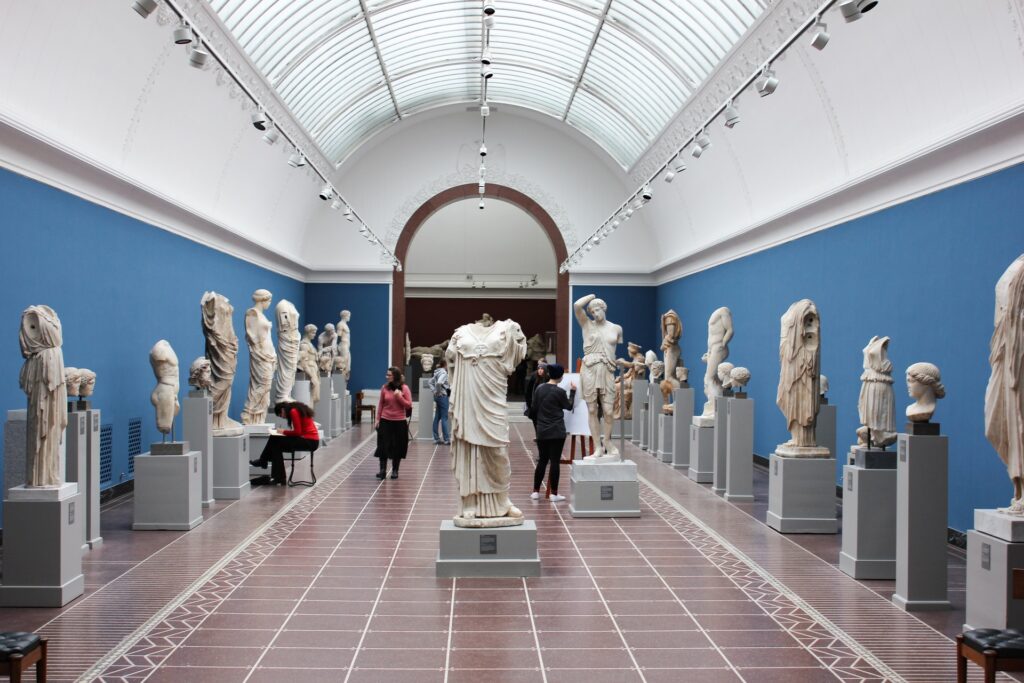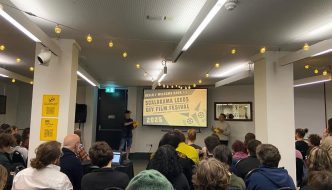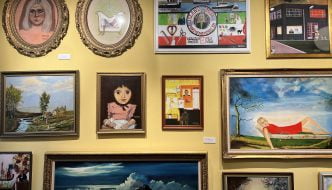
Photo by Lizzie George on Unsplash
It’s fair to say that museums and galleries have been hit hard in the fight against coronavirus, with almost an entire year in lockdown they’ve experienced an unprecedented decline in access, income and visitors. Understandably, many of those keen to get back amongst art, culture and heritage – myself included – were repeatedly left feeling disappointed as other public venues were temporarily allowed to reopen. Culture vultures took to social media to express their frustration, with some taking aim at the government’s decision to reopen betting shops, shopping centres and gyms in particular. Museums and galleries were promoted as rarified spaces whose clientele acted with civility, connoisseurship and civic consciousness. To reinforce this point, betting shops, shopping centres and gyms were cast as so-called ‘dens of iniquity’ frequented by the crude, careless and contemptible.
After reading some of these comments I imagined these venues looking like Hogarth’s ‘Gin Lane’, but instead of being drunk on mother’s ruin, patrons were intoxicated on bargains, jackpots and protein shakes. This all felt distinctly classist and wholly contradictory to the commitment many museums and galleries had recently made to equality, diversity and inclusion, or EDI as it’s commonly known. Given this unashamed inconsistency, just how confident can those of us from traditionally excluded groups be about the latest EDI craze in the arts and culture sector?
When I first saw the abbreviation EDI appearing with increasing frequency in job adverts, funding applications and institutional policies, I couldn’t help but think of electronic dance music, or EDM as it’s otherwise known. I imagined being sat in front of an interview panel and being asked to compare and contrast the back catalogues of Calvin Harris, David Guetta and Diplo. Imaginary interview scenarios aside, EDI does share a number of significant similarities with EDM. Both are dependent on the creativity, determination and resilience of oppressed communities, and both have been commoditised by a mainstream society motivated primarily by profit, productivity and pacification.
In her 2018 Billboard article ‘Gay Black Men Helped Create EDM. Why Do Straight White Men Dominate It?’, Katie Bain charts the Black LGBTQ+ roots of house music from Chicago in the 1970s to the global EDM phenomenon it is today, and asks how the music of a ‘mariginalized community’ is now almost exclusively the reserve of the ‘heteronormative mainstream’. This process of appropriation has allowed for diluted versions of both EDM and EDI to emerge – these versions are stripped of context, complexity and continuity to guarantee mass appeal and minimal cultural, political or societal discomfort. Success is dependent on download figures and visitor demographics respectively.
On a daily basis any number of museums and galleries can be found sharing their seemingly innumerable awards, accolades and achievements for EDI via social media, in an almost exclusively celebratory way – like DJs and their entourages jostling for the perfect Instagrammable moment on stage at an EDI festival. For traditionally excluded groups this can often feel rather specious, superficial, and an attempt to avoid the serious atonement required to ensure sector-wide systemic, structural and sustained change.
In an interview with Hazel Cills for her 2020 Jezebel article ‘Does the Museum Model Work?’, Chaédria LaBouvier – the first Black curator, Black woman and person of Cuban descent to curate a show at the Guggenheim and author of the accompanying catalogue ‘Basquiat’s Defacement: The Untold Story’ – stated that there ‘is an atonement that has to happen’ in order for museums to tackle discrimination and the racism, elitism and exceptionalism – which LaBouvier experienced firsthand – which underpins it. Without a critical and honest review of why we’re in such an unsatisfactory situation regarding EDI in museums and galleries – despite several decades of promising projects, programmes and placements – those on the periphery will remain apparently ‘hard to reach’ whilst performativity will prevail as the default position. At a time when there’s a desperate need for such introspection, EDI shouldn’t be reduced to an excessively optimistic over-filtered Instagrammable moment.
Without this accompanying reflexivity in the application and understanding of EDI within museums and galleries, it’s all too easy for infringements, incongruities and inconsistencies to emerge. A very obvious example of this has been the recent trend to uncritically resurrect, rehabilitate and rebrand the Victorian benevolent paternalistic motivations behind the establishment of many mainstream museums and galleries.
Like a scene from the 1989 film ‘Bill & Ted’s Excellent Adventure’, these institutions accompanied by marketing agencies leap back in time, retrieve their Victorian founders, but instead of a high school history presentation they work on a heritage branding strategy together. This romantic version of their establishment and its rebirth – one that redacts the inextricable connections to colonialism, classism and cronyism – is at odds with the very public pledges made about EDI. Given this, it’s unsurprising that attitudes reminiscent of Victorian puritanical moralising towards working-class past-times like betting, boxing and browsing emerged during lockdown.
At the recent QTIBIPOC online event ‘What does a Queer Museum Look Like?’ hosted by Tate, Sandy O’Sullivan – Aboriginal (Wiradjuri), transgender/ non-binary Professor of Indigenous Studies and Future Fellow (2020-2024) at Macquarie University, Australia – commented that the often glacial pace and perfunctory application of change in museums is a conscious decision and not an institutional idiosyncrasy.
The criticism of working-class recreational spaces emanating from some museums and galleries during lockdown was certainly delivered with conviction, and without apparent concern for contravening EDI commitments. It also threw into sharp relief the persistent, problematic and often paradoxical relationship some of these institutions still have with their Victorian benefactors. For the current incarnation of EDI to succeed – I’ve lost count of how many iterations there’ve been since I was a Museums, Libraries and Archives Council diversity champion a decade ago – there can’t be any room for indifference, ignorance or inconsistency.
Alternatively, museums and galleries need to make room to learn from those presumed ‘dens of iniquity’ such as nightclubs, many of which have EDI at their very core – like Manchester’s own resplendently ugly Homoelectric – and have been indefatigable about its implementation since their very inception.




Comments